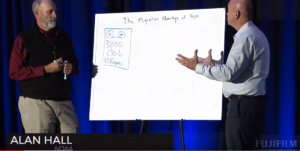Reading Time: 2 minutesBy Rich Gadomski

I just spent a full day at a meeting of the Active Archive Alliance and as I was flying home it occurred to me that it’s time for data storage managers to rise up from the sleepy status quo of buying more disk arrays to address runaway data growth problems. It’s time to wake up and smell the sweet aroma of freshly made modern data tape (sort of like that new car smell if you don’t know).
Why do that you ask? Because best practices and undeniable facts say so. Consider the following:
Data goes through a lifecycle from hot to cold, that is to say from a period of active use to a period of inactivity. This can happen in as little as 30 days or less.
Inactive data should not stay on primary storage devices. It takes up space on expensive storage media, consumes more energy and adds to the backup burden.
What to do? Delete it? You probably can’t get permission to delete it, all data is now potentially valuable with new artificial intelligence (AI) and analytic tools emerging to derive value from that data. But you can move it and stop copying it!
Where do you move it to? Put it in an active archive consisting of low cost disk cache and even lower cost long term storage like a high density automated tape library. To store one petabyte of data for 10 years in a tape library will cost around $220,000 depending on your TCO variables. Alternatively, you could spend $900,000 on HDD and around $1,300,000 for cloud. Need more capacity? Tape libraries easily scale by adding more slots and tapes. You can export full tapes and plug new ones in. Move the full tapes offsite and get the benefit of air gap since the data is physically isolated from other networks. At least you know that data can’t be accessed and held for ransom.
Getting end user access requests for that data all of a sudden? Move it back to disk cache and serve it from there. When done, move it back to the tape library. Tape is super-fast, 360 MB a second and file access is made easier and faster with LTFS.
How to orchestrate all this? Intelligent data management solutions help move data automatically. Leverage metadata and AI tools to analyze files and move them off primary storage if they don’t belong there.
Does this sound like a tiered storage strategy? It is and it’s also known as an active archive. This is a best practice used by the biggest and most advanced data generating companies in the industry. If it works for them, it will work for you too.
There’s a lot of hype in the storage industry with lots of folks looking for new, better ways to do things. But some things are tried and true, like tape, with the benefits of constantly evolving capacities, performance, reliability and long term archivability. So wake up and smell the tape…put your data where it belongs and get on with your day!



